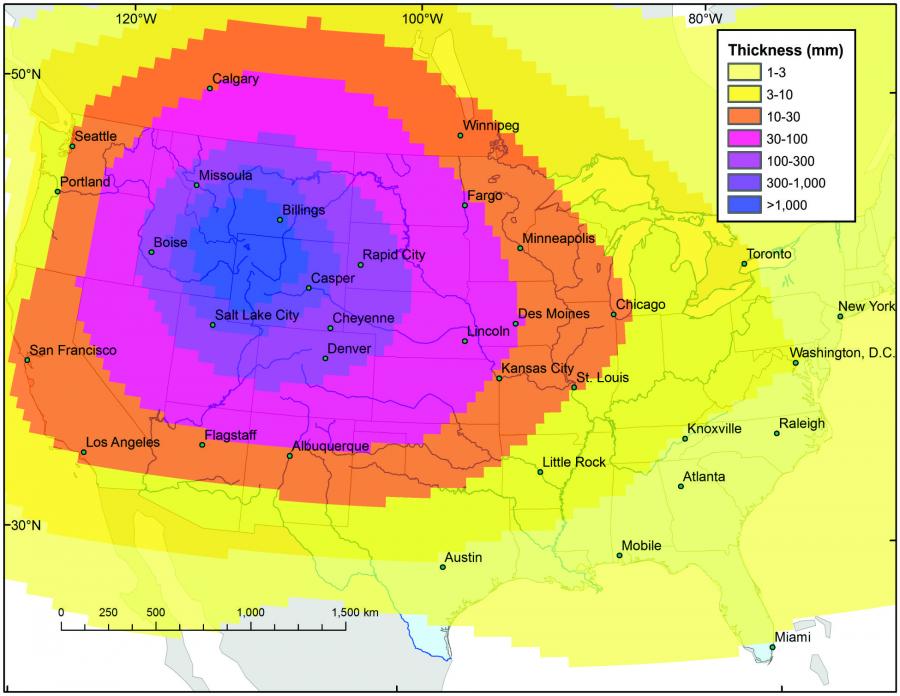With the recent world-wide flurry of volcanic activity and large earthquakes in Japan and Ecuador, some scientists are speculating we could see "the big one" fairly soon. On the list of big ones are the 8+ earthquakes along the San Andres Fault in California, major faults in Seattle and Salt Lake, the New Madrid Fault system along the Mississippi River Valley and volcanic eruptions in the Cascades, Sierra Nevada and Yellowstone. 3 previous super eruptions happened at Yellowstone 640,000, 1.3 million and 2.1 million years ago - about every 660,000 - 700,000 years or so. If it were completely linear (it's not) we should be good for a long time but we are certainly within the time span range where anything is possible.
The USGS has modeled the area and thickness of ash fall for a large event similar to the one 640,000 years ago. Link The model results show that there would be measurable ash over the entire United States and that the western US would be devastated.
Denver would be smothered in over a foot of ash, while Colorado would get between 2 inches in the southeastern corner to 3 feet of ash in the northwestern part of the state. How this would unfold would depend on the time of year and weather. The model assumes that the eruption would last for one month. The initial eruption would quickly cover everything in Colorado within a week's time. If there is no warning and evacuation prior to the eruption, there will be no immediate escape because ash in the air will clog the air intake on cars even if the roads were able to be cleared of ash. Survival will be dependent on having filter masks. The movie about Pompeii and the Vesuvius eruption of 79AD is probably as good a way to imagine what will happen as any. Here is a video of an ash cloud descending on a town in Mexico from a relatively small eruption.
The next problem after breathing will be removing the ash accumulation from critical infrastructure. Transformers will have to be cleaned or we will lose the electrical grid. Roofs will have to be cleared or they will collapse. Fossil fuel power plants will struggle to burn the fuel with ash saturated air. Filtration of water supplies will be a major, if not insurmountable challenge, and not possible if the grid is out. Food delivery will not be possible for at least a month and crops throughout much of the US will fail for at least a year after the eruption. The ash plume in the atmosphere will cause temperatures in the US to plummet 20 degrees during the first year Link and without power, heating will not be possible. In the mountains, rain and snow will combine with the accumulated ash to generate massive debris flows that will wipe out everything in their path. A home with solar cells and well water might be survivable but there will still be the problem of food. People will have no income as their jobs will no longer be there after the eruption. Most people in Colorado will lose their homes and become refugees if they survive the first month. I am hard-pressed to visualize how Colorado would recover from a disaster like the Yellowstone super eruption and re-build even though humans have historically shown great tenacity.
There is no way to prepare for this disaster short of moving somewhere far away. I'll take my chances and stay, the odds of it happening in the near future are incredibly low but I will say this. Unless the jet stream at the time of the eruption is flowing directly from Yellowstone to Colorado, there will be a window of about 8 - 16 hours between the initial eruption and when heavy ash would start to rain down in Denver. Upon news of the eruption, I will get my family into the car and head south toward Mexico.

No comments:
Post a Comment